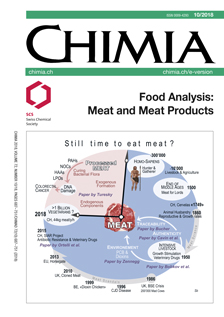Veterinary Drug Residue in Food of Animal Origin in Switzerland: A Health Concern?
DOI:
https://doi.org/10.2533/chimia.2018.713Keywords:
Antimicrobial resistance, Drug residue monitoring, Food safety, Meat product, National control plan, SwitzerlandAbstract
Many drugs are used in livestock farming, particularly antibiotics, with almost 80% of world antibiotic production used for animals. Therefore, veterinary drugs may be present as residues in food of animal origin even if their use is fully regulated to ensure the proper use of veterinary medicinal products, to protect consumers from undesirable residues, and to ensure the supply of quality, safe and effective veterinary medicinal products to safeguard animal health. Analytical techniques for residue analysis have improved significantly with routine use of liquid chromatography coupled with tandem or high-resolution mass spectrometry. This improvement enabled specific searches for several hundred target compounds within minutes in complex matrices such as milk, eggs, honey or meat and organs after slaughter. For many years, a national residue control programme in food has been effective. The rate of non-compliant samples remains low and shows that consumers do not have to worry too much about the presence of drug residues in food of animal origin produced in Switzerland. Despite the significant reduction in antibiotic consumption observed in recent years, the resistance rate and distribution of multidrug-resistant bacteria is steadily increasing, even in countries where drug consumption has decreased significantly. Reducing antimicrobial resistance will undoubtedly be one of the most difficult food safety challenges in the coming years.Downloads
Published
2018-10-31
How to Cite
[1]
D. Ortelli, A. S. Spörri, P. Edder, Chimia 2018, 72, 713, DOI: 10.2533/chimia.2018.713.
Issue
Section
Scientific Articles
License
Copyright (c) 2018 Swiss Chemical Society

This work is licensed under a Creative Commons Attribution-NonCommercial 4.0 International License.







